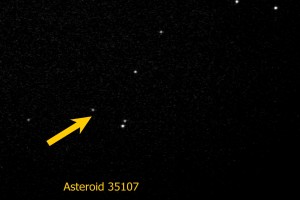Fortunately, there are programs to search for and track these flying mountains-also called "Near Earth Objects" (NEOs)-and I'm very pleased to announce that Chabot Space & Science Center (specifically our 36-inch reflecting telescope, "Nellie") has very recently become an official contributor to the NEO search program of the International Astronomical Union's Minor Planet Center (MPC)! Nellie is designated by the MPC as Observatory G58.
In this MPC program, observatories around the world contribute by searching for and tracking NEOs: asteroids, and comets, whose orbits can carry them close to Earth and which are large enough to cause catastrophic damage should they hit us.
In order to take part in the NEO program, Chabot observers Conrad Jung (on the Chabot staff) and Gerald McKeegan (of the Eastbay Astronomical Society) conducted a four-month program to develop and hone the necessary skills and data processing techniques, as well as to configure telescope equipment, to meet MPC qualifications.
To that end, they observed a set of known asteroids-some NEO's and some "Main Belt" asteroids. (One of these Main Belt asteroids, "Carter 10683," was named for former Chabot board member and president of the Eastbay Astronomical Society, Carter Roberts, who, sadly, passed away earlier this year.)
Chabot's asteroid hunters will begin their tenure of official asteroid observation by verifying the orbits of recently discovered NEOs and reporting the additional observations to the MPC, where it will be used to refine our knowledge of the NEOs' orbits. The next step in the program will ultimately be to hunt for currently undiscovered asteroids.
The process for finding, tracking, and reporting NEO observations goes something like this. With a digital (CCD) camera attached to the telescope, a section of the sky is imaged three or four times in a half-hour period. The images are processed and compared, and any star-like dots that are found to move between one image and the next become suspect asteroids. (The word "asteroid," by the way, literally means "star-like"-so named because through most telescopes asteroids are too far away and too small to appear as anything more than points of light.)
The coordinates of any moving dots are calculated for all of the images they are in, and this information is sent to the MPC to be added to the data from other NEO hunting observatories. From the combined observations of all the observatories, a precision database of the orbits of near-Earth rocks is maintained, and with it NEOs that may pose a threat to the Earth may be identified.
Hunting NEOs may be like searching for needles in a really big haystack-but in jobs like this, the more eyes on the problem the better. Nellie is now one more eye on lookout duty...
Click here for a closer view of the asteroid shown above.
37.7631 -122.409
 Asteroid 35107, captured on Chabot Space
Asteroid 35107, captured on Chabot Space